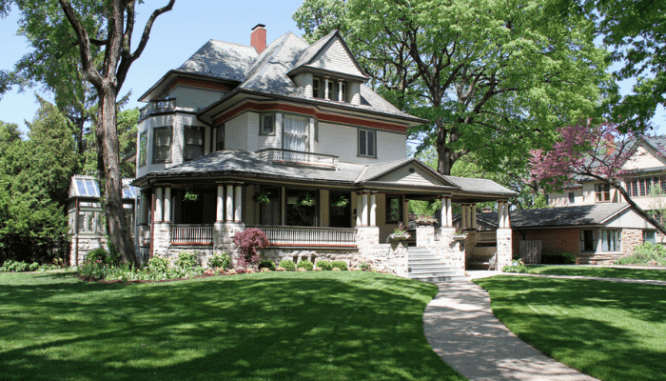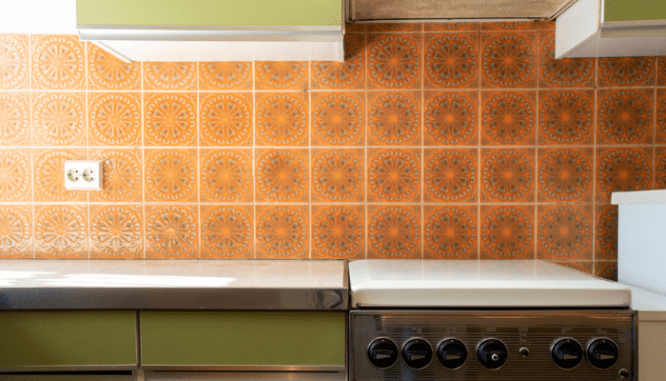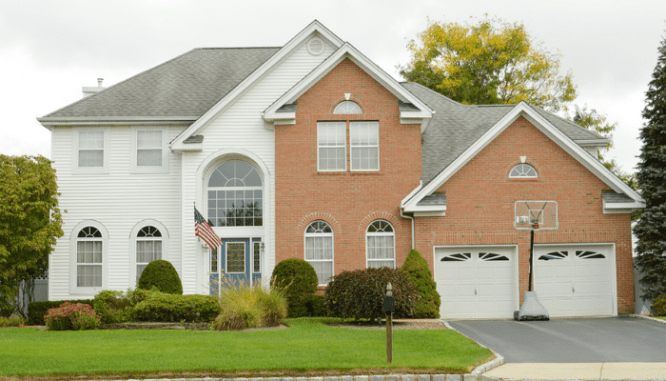What Are the Best Home Improvements for Resale? Expert Tips
- Published on
- 9 min read
-
 Kate Van Pelt Contributing AuthorClose
Kate Van Pelt Contributing AuthorClose Kate Van Pelt Contributing Author
Kate Van Pelt Contributing AuthorKate Van Pelt is a writer and editor based in Oregon, with a background in home improvement, marketing, and finance. She has owned, remodeled, and rented properties and has developed a thorough understanding of effective home-buying tips and trends along the way.
From original crown molding to rust-colored shag carpeting, every home has its perks and its quirks. But when you’re preparing to sell, how do you know what features will appeal to buyers and which ones will scare them away? The best home improvements for resale all depend on your home’s age.
We talked with three real estate agents from California to Massachusetts to discover the best home improvements for resale based on the year your home was built. In our comprehensive guide, you’ll find two tips for every decade, including remedies for common building errors of the era and easy design updates that increase your home’s value.

Historic homes: Pre-1890
Homes built before 1980 are true specimens. Elaborate Victorians possess gorgeous ornamental trusses, while Colonials feature thick pillars bordering the front door. No matter the design, these homes are treasured by many homeowners and coveted by buyers.
Urgent home improvement: Repair foundation flaws
As time progresses, dirt shifts and foundations settle. If you own a historical home, check the foundation for cracks and sags. These issues can intensify over time and create a ripple effect in your home, leading to water damage, slanted floors, and even bowing walls.
According to estimates from HomeGuide, a minor foundation crack may cost just $620 to repair. If there’s a significant problem, on the other hand, prepare yourself for a steeper bill. The average cost for foundation repair is $4,511.
Consult at least three licensed contractors who have experience working on older properties to determine how to best repair your foundation before selling.
Recommended design update: Focus on functional improvements
The benchmark for necessary amenities has changed over the years, but any buyer seriously considering an 1860s Greek Revival or an 1880s Queen Anne home wants a property that exudes historic charm.
“What buyers want today, in a perfect world: Everything is new, but you feel like you’re walking into an 1800s home,” says Spring Cutsforth, a top agent in Portland, Oregon, with nearly 30 years of experience.
As you pursue any additions or modifications, skip those which threaten to compromise the building’s character. Instead, focus on functional improvements to increase your home value. For instance, buyers are 50% more likely to make an offer on a property with new stainless steel appliances in the kitchen.
Pre-war homes: 1890 to 1940
The early 1900s marked a sudden shift away from the ornate and towards simplicity with the emergence of Craftsman style architecture. Craftsman homes feature low-pitched rooflines, built-in furniture, and a central fireplace. Still, despite their minimal aesthetic and functional appeal, houses of this era come with construction woes and design defects.
Urgent home improvement: Fix dated knob-and-tube wiring
In the early 1900s, most builders used knob-and-tube (K&T) wiring. This electrical system does not meet today’s insulation standards and is considered a fire hazard. Some insurance companies won’t even cover homes with K&T wiring unless a certified electrician deems the system safe.
“Electrical was done differently back then,” comments Janet Anderson, a top agent in Tracy, California, who sells homes more than 26% faster than an average agent. Anderson suggests that homeowners hire a licensed electrician, typically for $110 to $125 per session, to inspect your home for K&T wiring. “A lot of times, an electrician can put [a homeowner’s] mind at ease.”
If worse comes to worst, replacing an existing system costs $8,000 to $15,000 on average for a 1,500 to 3,000 square foot home.
Recommended design update: Enhance historic features
Buyers adore pre-war homes for their quality architecture and unique interior design. Find ways to restore your home’s original features rather than replace them.
“What’s sad is when you see an investor pick up an older home, and then they put all modern features in it,” says Cutsforth. “You start to destroy the character and charm that people are wanting.”
Paint the corbels of your 1930s Craftsman home in this soft Cottage White or bold Maple Glaze from Behr. Polish and repair any original light fixtures or glass doorknobs. You can find additional vintage fixtures online from retailers like House of Antique Hardware. And, if you’re lucky enough to have a transom window or laundry chute, keep those novelties alive and well!

1950s
In the 1950s, architectural icons like Frank Llyod Wright and Cliff May perpetuated simple, minimal trends. Wright’s Prairie Modern and May’s Ranch-style home featured clean lines, natural materials, and integration with the outdoors. While homes built in this era remain stylish today, they often contain hazardous building materials that you’ll want to replace before you go to sell.
Urgent home improvement: Replace ungrounded outlets
In the 1960s, builders continued to improve electrical systems. Charles Dalziel, an electrical engineering professor, invented the ground-fault circuit interrupter (GFCI) in 1961 to prevent electrical shocks. The following year, the National Electrical Code mandated grounded three-prong outlets for all new-build homes in the United States.
If your home has any two-pronged outlets, replace them with GFCI outlets before you sell. According to HomeAdvisor, this project typically costs between $132 and $287.
Recommended design update: Eliminate busy flooring
In the 1950s, contractors began to incorporate mixed flooring in residential homes. As you roam from room to room, tile transitions to carpet, which transitions to linoleum and so on — a trend that modern-day buyers dislike. “Today’s buyers like uniform,” Anderson advises.
If your home’s still rocking grandma’s linoleum, replace it with hardwood flooring. In a survey from the National Wood Flooring Association, agents agreed that homes with hardwood floors sell for as much as 10% more than homes without wood flooring.
If you already have hardwood, refinish the floors to restore their beauty. You can tackle this project DIY-style for less than $500 for 275 square feet, or you can hire a professional at $1.50 to $5.00 per square foot.
1960s
The dawn of hippiedom, 1960s did away with the prior decade’s minimal, buttoned-up home design. Bold colors replaced muted tones, loud prints and patterns overpowered clean lines, and lava lamps dethroned acrylic grape centerpieces.
Unfortunately, most buyers prefer the crisp style of Mid-century Modern design to the groovy ‘60s aesthetic. Not to mention, building materials in ‘60s homes can host toxic substances (and we’re not talking about the psychedelic kind). The best home improvements for resale address these issues, so your buyer doesn’t have to.
Urgent home improvement: Check for asbestos and lead-based paint
Before the 1980s, asbestos was used in a variety of building products, including insulation and floor tiles. While medical journals began publishing articles linking asbestos to cancer as early as the 1930s, it wasn’t until the 1970s that the Environmental Protection Agency (EPA) began banning certain asbestos-related products that release toxic particles when damaged. Testing kits are available, but it’s best to hire a professional for around $494 since asbestos is not harmful unless it’s distrubed.
Lead-based paint is another toxic material common in 1960s homes, especially on the exterior. The federal government officially banned lead-based paint in residential homes in 1978. Hire a professional to remove any chipping or flaking lead paint from your home since this material is hazardous if consumed or inhaled. If you need to remove flaking paint, the project costs $5,000 to $15,000. However, if your paint is in good shape, you can safely cover it with a fresh coat every four to ten years to prevent harmful exposure. Either way, you’ll need to disclose the lead-based paint in a seller disclosure form before selling your home.
Recommended design update: Tame the interior color scheme
Flashy colors were the norm in the 1960s, but in HomeLight’s Top Agent Insights Report for Q1 2020, 98% of top agents agree modern buyers prefer neutral tones.
Although wallpaper has made a recent comeback, the styles have evolved over time. Replace dated floral wallpaper and brightly painted walls with white or greige paint, like Pure White from Sherwin Williams or Benjamin Moore’s Edgecomb Gray.

1970s
The Ranch-style home remained popular through the ‘70s, as builders began to introduce more open floor plans. Unfortunately, what this decade gained in space, it lacked in taste.
Dark wood paneling, wall-to-wall carpeting, and loud wallpaper made rooms feel smaller. If your home’s still originally outfitted, there are several simple, affordable ways to update its passé design.
Urgent home improvement: Replace faulty electrical panels
In the mid-1900s, brands like Federal Pacific Electric (FPE) and Zinsco were the leading manufacturers of electric panels in U.S. homes; however, popular products like the FPE Stab-Lok breaker panel are prone to fail, resulting in more than 2,800 fires each year. If you find the FPE or Zinsco label on your panel, call a local, licensed electrician and prepare yourself for an average repair cost of $1,932.
Recommended design update: Remove dated flooring
Along with fads like floral wallpaper introduced in the 1960s, the ‘70s perpetuated bright flooring designs, featuring favorite colors like avocado green and sunshine yellow. “You want to get rid of that seventies style,” Anderson advises.
Replace colored flooring and shag carpet with wood flooring. The National Association of Realtors® 2019 Remodeling Impact Report suggests that new wood flooring recovers 106% of project costs making it the best interior home improvement project for resale.
Anderson recommends laminate flooring as a low-cost alternative, like this rustic oak option at Home Depot for just $1.99 per square foot.
1980s
From the hair to the homes, everything got a little bigger in the 1980s. According to data from the National Association of Realtors®, the median size of homes purchased grew substantially in the ‘80s, from an average of 1,700 square feet in 1981 to 2,000 in 1993. Unfortunately, the ‘80s are also known for trends we now consider garish, like pastel paints and wall-to-wall mirrors.
Urgent home improvement: Address polybutylene pipes
Polybutylene (PB) is a cheap, flexible plastic used in residential plumbing systems between 1978 and 1995 — until builders discovered the material corroded rapidly and ruptured when exposed to some disinfectants.
If your home has PB pipes, you’re not required to replace them, but they may scare off buyers and reduce your home value. The cost for a whole-house pipe replacement ranges from $1,500 to $15,000, depending on the piping you select, your home’s size, and your location.
Recommended design update: Update kitchen cabinets and countertops
Nothing dates a home more than an ‘80s-style kitchen. In fact, 40% of real estate agents encourage sellers to pursue an upgrade before listing their property, and 20% share that kitchen improvements have helped close sales!
To cut costs on your kitchen reno, select an affordable, neutral laminate to replace your Formica or tile countertops. Instead of tearing out your old oak cabinets, paint the cabinets gray or white.
“You can just do things that are very minor to really give your kitchen a facelift, so it appeals to buyers and gets you the top dollar,” says Anderson.

1990s
In the 1990s, Americans embraced the mantra “bigger is better” with McMansions. These suburban homes displayed grand entryways, three-car garages, and plenty of space — generally between 3,000 and 5,000 square feet. Consequently, if you own a 1990s property, you may have a little more ground to cover to prepare your home for buyers.
Urgent home improvement: Amend exterior insulation and finish systems (EIFS)
In the 1990s, barrier exterior insulation and finish system (EIFS) was a popular building cladding system that provided homes with insulation and protection from water damage. Years later, contractors and homeowners eventually realized that EIFS retained moisture, leading to mold and mildew issues.
The system has improved since, but if your home has EIFS, you should still hire an experienced home inspector to evaluate the system and check for mold. If you catch the problem early, repairs are minor and cost around $1,000 to $2,000.
Recommended design update: Update brass and gold hardware
The typical ‘90s home features polished brass fixtures and hardware. Yes, brass is back, but today’s iteration flaunts a matte finish. So, you still need to replace old shiny gold fixtures if you want to update your home’s look.
Swap out lighting fixtures, door handles, bathroom faucets, kitchen handles, and any other element finished with the brass of the past. Choose a contemporary finish such as matte black or stainless steel to use throughout your home.
2000s
While the tiny home movement gained a little traction after the 2008 housing market crash, McMansions were still all the rage at the start of the twenty-first century. The median home size continued to rise to an average of 2,700 square feet in 2009 as builders added more bedrooms and bonus rooms than ever.
Urgent home improvement: Inspect shoddy, rushed construction
The 2000s experienced a substantial housing boom before the market crash of 2008, and some builders sacrificed quality for the sake of speed.
“Builders have a history of constructing homes in their town,” comments Laura McKenna, a top agent outside of Boston, MA, with 36 years of experience. “Some were thoughtful and took pride in the quality of the home construction. Others were focused on return on investment and took some short cuts.”
With a vast array of issues, like cracking floors and water-logged insulation, homes built in this decade are often riddled with defects, which could delay or even jeopardize your sale. Avoid inspection drama down the line and hire a home inspector before you list your home. On average, home inspections cost around $337.
Recommended design update: Add a home office
Although the number of bathrooms and bedrooms in newer homes increased, many homes built in the 2000s lack a designated office space. If you want to attract buyers, build an addition or stage a spare room as a home office. According to HomeLight’s Top Agent Insights Report, Q3 2020, 39% of homebuyers who moved for work-related reasons did so to find a property with a home office.
Design the office with minimally decorated bookshelves and a simple desk like this one from Wayfair. Finally, dress up your workspace with decorative touches, such as plants and a stylish accent chair.

At the end of the day, the “bones” matter most
While buyers may find some eras more attractive than others, every decade has its share of home design flops.
“There are poorly constructed, and well-constructed homes built in every decade,” says McKenna.
“I rarely focus on the decade of a home when I am showing a home, but I’m very focused on ‘the bones.’”
Before you list your home, hire an experienced home inspector to identify any significant structural issues. As for design, every decade has its flaws and its features, but which deserve a seller’s time and money depend on several factors, including your home’s overall condition compared to the competition and the state of the market.
“Right now inventory is so low that the things that you might have had to do yesterday you may not need to do today,” says Anderson. “That’s why you would definitely want to talk to a real estate professional.”
When in doubt, consult a top real estate agent for advice. They’ll let you know what cosmetic upgrades and home repairs are most likely to increase your home’s value and marketability in your particular market.
Header Image Source: (Robert Crum / Shutterstock)
